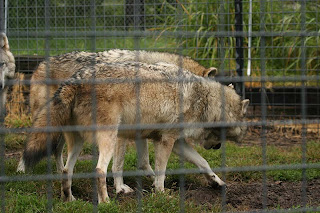Pros of zoo photos for reference:
Readily available- most large cities and some small ones have zoos. Cost to get into them is usually between $5 and $25.
Animals are in close proximity, enabling you to get close photos with even a medium sized zoom. I often use my 70-200 lens on my DSLR, and occasionally make use of my 100-400mm lens. The less expensive 70-300 lenses will work great too and since at most zoos the animals are outside in natural light the slower lenses do ok.
If one species is not active or sleeping, find another one! Lots to choose from and check back later to see if your favorites are awake. Most animals are more active earlier and later in the day and in cooler weather. Winter can be a great time for a zoo trip!
Capturing the moment can be a challenge sometimes due to bars or plexiglass, but sometimes you can capture some unique behaviour up close and personal without risk of injury to yourself. I have been just feet away from young grizzly bears wrestling- something I would never do in the wild!
Cautions of zoo photography references:
The animals are sometimes obese- something they pretty much never would be in the wild. If you draw the animal in a wild setting the way you see it in the zoo think about this kind of thing. Wild animals also tend to me more muscular since they have to actively work to get food.
Know your critter and its environment! While your zoo photo may have a red panda up in a pine tree, you should make sure that that is a tree that you would find it climbing in the wild. Got a great photo of a cheetah in the snow? Not something you are likely to find in Africa! Sometimes it will take research and additional photos to make sure that the animal and the environment you put it into are going to match up.
The challenges of bars and glare or scratched up plexiglass can be frustrating. For bars try to get your camera lens as close to the bars as possible and zoom in. Also the further the animal is from the bars the less they will show in the image. Sometimes even with the best efforts you will get some 'shadow' bars. At this point try to make sure that the most important things, such as the eyes of the animals are not obstructed. For plexiglass also try to put your lens very close or right up against it. Try to find an area with less scratches or frosted look to shoot from.
Reflections in the eyes often show the cage bars in them. Use artistic license to remove the bars and put a more natural highlight. Also sometimes the bars will leave shadows- you wouldn't want to put these in either.
In this photo my lens is zoomed out and the wolves are about 20 feet from the bars. The bars are very visible in the photo. I can see enough details that this photo would still be usable for a reference.
This wolf is also about 20 feet from the bars, but I have now zoomed all the way in. The bars are almost invisible.
A third wolf image, and again I quite zoomed in, but in this case the wolf is only about a foot from the bars. As a result to the close proximity of the bars they are quite noticeable. I try to make sure the eyes are not obstructed. can use supplemental photos to get the nose and other details.
This mountain Lion photo shows some glare as a result of taking the photo through plexiglass. Nevertheless, quite a usable reference as I can see all the details I need.
This cheetah has a look that will stop you in your tracks, but I could not paint him in the scene found in this photo. This cat lives in Denver where it snows, but you are not going to find this in Africa!
This captive black bear is so fat that his stomach is nearly dragging the ground. You would never find a bear this obese in the wild!







No comments:
Post a Comment